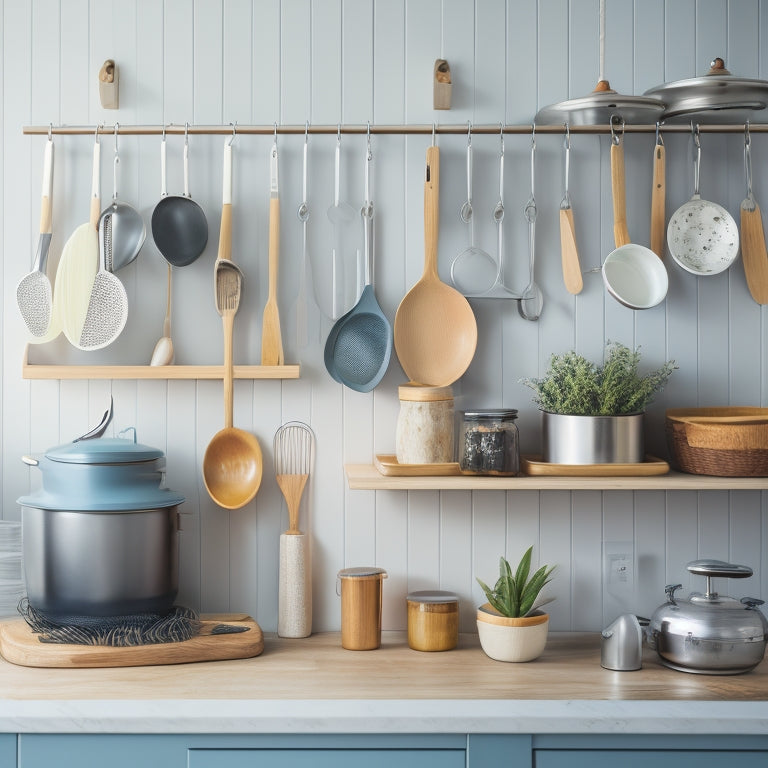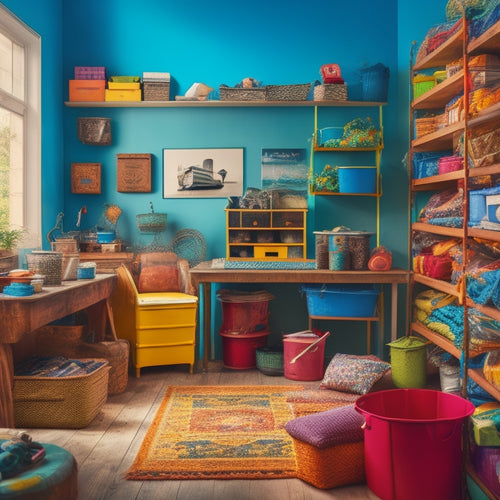
What's the Best Way to Organize Kitchen Utensils?
Share
You're ready to tame the chaos of your kitchen utensil collection. Start by evaluating what you have, identifying duplicates, and investing in multi-purpose utensils. Group similar items together and create functional categories for baking, cooking, and serving. Assign a home for each item, utilizing storage solutions like utensil holders and wall hooks. Maximize your drawer and cabinet space with dividers, inserts, and vertical storage options. With a solid organization system in place, you'll be cooking up a storm in no time. Now, take the next step and discover how to maintain your newfound kitchen harmony.
Key Takeaways
• Categorize utensils by function (baking, cooking, serving) and store similar items together in designated areas or containers.
• Invest in multi-purpose utensils and eliminate duplicates or unused items to declutter your kitchen.
• Utilize storage solutions like utensil holders, wall hooks, and drawer dividers to maximize storage capacity and accessibility.
• Establish a daily routine for putting away utensils after each use and set regular cleaning schedules to maintain organization.
• Assign a specific spot for each utensil and clearly label storage areas to ensure easy identification and retrieval.
Assessing Your Kitchen Utensil Collection
Take stock of the kitchen utensils you currently own, considering which ones you use regularly, which ones are duplicates or triplicates, and which ones are broken or no longer serve a purpose. This is the first step in utensil decluttering tips.
Be honest with yourself - when was the last time you used that garlic press or pastry brush? If it's been months, it's probably safe to get rid of it.
Next, assess the quality of your utensils. Are they durable and easy to clean, or do they fall apart at the slightest hint of moisture? Consider investing in high-quality, multi-purpose utensils that can replace the low-quality ones. This won't only optimize your storage solutions but also make cooking more efficient.
When organizing small gadgets, group similar items together, such as all your measuring spoons or spatulas. Store them in a designated area, like a utensil organizer or a drawer divider.
Categorizing Utensils by Function
Categorize your kitchen utensils into functional groups, such as baking, cooking, and serving, to create a logical and easy-to-navigate system. This approach helps you identify which utensils are used together and makes it easier to access the tools you need when you need them.
| Category | Utensils | Storage Ideas |
|---|---|---|
| Baking | Whisk, rubber spatula, pastry brush | Utensil holders with color coding, countertop caddies |
| Cooking | Tongs, slotted spoon, wooden spoons | Wall hooks, utensil holders with dividers |
| Serving | Serving spoons, serving forks, salad tongs | Countertop caddies, utensil holders near serving area |
Assigning a Home for Each Item
Now that you've grouped your kitchen utensils into functional categories, it's time to assign a specific home for each item within those groups. This step is essential in maintaining an organized kitchen. Start by designating a specific area or container for each category.
For instance, you can use utensil crocks or pots near the cooking station for frequently used items like spatulas, whisks, and wooden spoons.
To take it a step further, consider implementing a color-coding system to differentiate between categories. For example, you can use red labels for baking utensils, blue for cooking, and green for prep work. This visual system will help you quickly identify where each item belongs, making it easier to maintain order.
Assign a specific spot within each category for each item, ensuring that everything has a designated home. This might mean allocating a specific hook for your most-used spatula or a particular shelf for your baking sheets.
Maximizing Drawer Storage Space
Now that you've assigned a home for each item, it's time to make the most of your kitchen drawers.
You'll want to create a system that keeps utensils organized and easy to access, and that's where utensil categorization systems, drawer dividers and inserts, and vertical storage solutions come in.
Utensil Categorization Systems
By grouping similar utensils together, you can create a logical system that optimizes your drawer storage space and reduces clutter. This categorization system allows you to store utensils in a way that makes sense, facilitating easy retrieval when needed.
One effective way to categorize your utensils is by function, such as grouping all baking utensils together, or all cooking utensils together. You can also use color coding utensils to distinguish between categories, making it simple to identify which utensils belong where.
Additionally, consider implementing utensil rotation techniques, where you store your most frequently used utensils in the front of the drawer and less frequently used ones towards the back. This guarantees that the utensils you need most are always within easy reach.
Drawer Dividers and Inserts
You can optimize your kitchen utensil storage even more by incorporating drawer dividers and inserts. These tools enable you to allocate specific spaces for different utensil categories, keeping them organized and preventing clutter from building up.
These dividers and inserts allow you to create customized compartments that fit your unique kitchen needs. For instance, you can designate a section for utensils used for baking, another for cooking, and so on.
Customized dividers and stylish inserts can be used to create adjustable compartments that maximize your drawer's storage capacity. This means you can store more utensils in a smaller space, making the most of your kitchen's real estate.
Additionally, these dividers and inserts make it easy to access the utensils you need, saving you time and effort. By implementing a well-organized drawer organization system, you'll be able to find the utensils you need quickly, and maintain a clutter-free kitchen.
Vertical Storage Solutions
To further optimize your kitchen utensil storage, consider installing vertical storage solutions that allow you to maximize your drawer's storage capacity by stacking utensils vertically, making the most of the available space. This approach enables you to store more items in a smaller footprint, keeping your kitchen organized and clutter-free.
Wall-mounted racks and hanging hooks are excellent options for storing utensils like pots, pans, and colanders, keeping them easily accessible while freeing up valuable drawer space.
Alternatively, stand-alone holders and under-shelf baskets can be used to store items like spices, oils, and condiments, keeping them organized and within reach.
By utilizing vertical storage solutions, you'll be able to locate items quickly, reduce clutter, and create a more efficient kitchen workflow. With a little creativity and planning, you can transform your kitchen into a highly functional and organized space that makes cooking and entertaining a breeze.
Utilizing Vertical Cabinet Storage
Maximize your kitchen's potential by outfitting your cabinets with vertical storage solutions that keep utensils organized and easily accessible. By utilizing the often-wasted vertical space in your cabinets, you can create a more efficient and organized kitchen.
Consider installing wall-mounted shelves or racks to store less frequently used utensils, freeing up space in your drawers and countertops.
To take it a step further, incorporate hanging hooks into your vertical storage solution. These can be used to hang items like pots, pans, utensil holders, and even aprons, keeping them off the countertops and out of the way. This won't only create more space but also make it easier to find what you need when you need it.
Creating a Utensil Station
Designate a specific area of your kitchen countertop as a utensil station, where frequently used items like knives, cutting boards, and can openers are kept within easy reach. By doing so, you'll create a hub for food preparation that streamlines your workflow and saves time.
A well-designed utensil station should be functional, yet visually appealing, and tailored to your cooking style.
Consider the following essential elements to include in your utensil station design:
- A knife block or magnetic strip to store your knives safely and within reach
- A small cutting board or chopping block for quick food prep
- A can opener or other frequently used gadgets in a designated holder
When planning your utensil station, keep in mind space-saving solutions that maximize your countertop real estate. Look for compact designs, wall-mounted options, or multi-functional tools that serve more than one purpose.
Maintaining Organization Over Time
Now that you've created a utensil station, maintaining it's crucial. To keep your kitchen organized, you'll need to establish habits that are vital for ensuring your utensils stay tidy and within reach.
Daily Utensil Maintenance
To maintain your newly organized kitchen utensils, you'll need to establish a daily routine that includes putting away items after each use and wiping down countertops to prevent clutter buildup. This habit will help you stay on top of utensil cleanliness and make sure your storage solutions continue to serve you well.
Here are some daily habits to get into:
-
After each meal, wash and dry utensils before storing them in their designated storage spaces.
-
Take a few minutes to clean countertops and the sink area to prevent crumbs and spills from accumulating.
-
Quickly check your kitchen to identify any utensils that are out of place and return them to their designated spots.
Regular Cleaning Schedules
You'll want to establish a regular cleaning schedule to maintain your organized kitchen utensils and prevent clutter from accumulating over time. This will guarantee your kitchen remains functional and efficient. Set specific days and times for cleaning different areas, such as daily, weekly, and monthly tasks.
| Frequency | Task | Tips |
|---|---|---|
| Daily | Wipe down countertops | Remove crumbs and spills promptly to avoid sticking |
| Weekly | Clean utensil drawers | Declutter and arrange utensils, and wipe down drawers |
| Monthly | Deep clean utensil holders | Soak utensils in hot soapy water, and scrub holders with a mild abrasive |
Storage Area Management
Establish a home for each utensil within your designated storage areas to maintain organization over time. This means assigning a specific spot for each item, making it easy to find what you need when you need it. By doing so, you'll avoid clutter buildup and save time searching for misplaced utensils.
To take your storage area management to the next level, consider the following strategies:
-
Implement color coding by categorizing utensils by type or frequency of use, and storing them in corresponding colored bins or baskets.
-
Maximize vertical space by installing hanging hooks for items like pots, pans, and utensils, keeping them organized and within reach.
-
Label each storage area clearly, so you can quickly identify what's inside without having to dig through everything.
Frequently Asked Questions
How Often Should I Clean My Kitchen Utensil Organizers?
"As you reign over your kitchen domain, remember to conquer clutter by cleaning your utensil organizers every 1-2 weeks, maintaining a hygienic and organized space that fuels your culinary creativity and power."
Can I Use Adhesive Hooks on My Kitchen Cabinets?
You can use adhesive hooks on your kitchen cabinets to optimize cabinet organization, freeing up space for utensil storage and other essentials, ensuring a clutter-free kitchen that boosts your productivity and efficiency.
Are Bamboo Utensil Organizers Better Than Plastic Ones?
When choosing utensil organizers, you're weighing eco-friendliness against budget; bamboo options reduce environmental impact, but plastic ones might be more affordable, so consider durability vs. cost to make an informed decision that suits your needs.
Can I Store Sharp Knives in a Utensil Organizer?
You shouldn't store sharp knives in a utensil organizer, as it compromises knife safety. Instead, opt for specialized storage solutions like knife blocks or magnetic strips to keep your blades secure and within reach.
Are Utensil Organizers Worth the Investment for Small Kitchens?
You're wondering if utensil organizers are worth the investment for your small kitchen. Honestly, they're a great space-saving solution, but if you're on a budget, consider alternative options like DIY organization ideas or budget-friendly alternatives that'll maximize your kitchen's potential.
Related Posts
-

What Are the Best DIY Storage Hacks Online?
You're looking for the best DIY storage hacks online! You've come to the right place. From repurposing old pallets an...
-

Mastering Closet Organization With Digital Tools
You're ready to tame the chaos in your closet, and digital tools are here to help. Start by accessing online tutorial...
-

Clear Digital Clutter for a Peaceful Mind
You're tired of feeling anxious and mentally fatigued, but do you know that your cluttered digital space is a major c...


